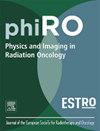Topogram and 3DCT geometry calibration for image-guided proton therapy with in-room CT-on-rails
IF 3.3
Q2 ONCOLOGY
引用次数: 0
Abstract
In-room computer tomography (CT) on-rails scanners are available in proton therapy centers but often limited to control imaging, due to geometric distortion and lack of integration. We present a calibration method combining CT-on-rails with a robotic table to achieve sub-millimeter patient positioning accuracy. Geometric distortions in 3DCT and topogram images were corrected using affine models and validated with laser tracker data. Phantom experiments simulating clinical conditions showed errors below 0.15 mm for 3D/3D and 0.3–0.55 mm for 2D/3D registration, the latter using a novel algorithm for digitally reconstructed topograms. The workflow enables accurate positioning without isocenter verification, supporting high-precision radiotherapy.
室内CT-on-rails成像引导质子治疗的地形图和3DCT几何校正
室内计算机断层扫描(CT)轨上扫描仪可用于质子治疗中心,但由于几何畸变和缺乏集成,通常仅限于控制成像。我们提出了一种结合CT-on-rails和机器人工作台的校准方法,以达到亚毫米级的患者定位精度。利用仿射模型对三维ct和地形图图像的几何畸变进行校正,并用激光跟踪器数据进行验证。模拟临床条件的幻影实验显示,3D/3D配准误差在0.15 mm以下,2D/3D配准误差在0.3-0.55 mm之间,后者使用了一种新的数字重建地形算法。该工作流程无需等中心验证即可实现精确定位,支持高精度放疗。
本文章由计算机程序翻译,如有差异,请以英文原文为准。
求助全文
约1分钟内获得全文
求助全文
来源期刊

Physics and Imaging in Radiation Oncology
Physics and Astronomy-Radiation
CiteScore
5.30
自引率
18.90%
发文量
93
审稿时长
6 weeks
 求助内容:
求助内容: 应助结果提醒方式:
应助结果提醒方式:


